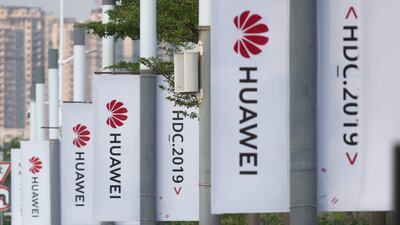Huawei's three-month reprieve from a US Entity List - effectively banning American companies from doing business with China's biggest tech company - is about to come to an end.
The National looks at the future of Huawei as Washington is expected to decide next week what comes next for doing business with the tech giant.
Why is August 19 an important date for Huawei?
The White House placed Huawei on a commerce blacklist on May 17, accusing the Chinese company of espionage and raising questions over the security of its 5G equipment. This ban immediately barred some of Huawei's biggest suppliers - such as Google, Intel, Qualcomm and Xilinx - from doing business with it. However, on May 21, President Donald Trump withdrew the ban - granting Huawei a three-month cushion after American tech stocks tanked. It allowed US companies to resume business with Huawei but the truce ends on Sunday, August 18.
What makes the ban potentially damaging to Huawei?
Huawei is one of the biggest buyers of US-made chips - used in making semiconductors for smartphones and other telecoms components.
Outside China, Huawei smartphones and laptops completely rely on Google’s Android and Microsoft’s Windows operating systems. Any disruption in the supply of hardware and software from American manufacturers will derail Huawei’s sales, as half of its revenue is generated outside its home market.
What is Huawei doing in response to US action?
Huawei rolled out its own operating system, an alternative to Google's Android called HarmonyOS, last week. For now, it is being used only in its smart TVs and is a "plan B" the company said it would prefer not to deploy further, preferring Google.
Huawei could also move away from US manufacturers and start buying components from South Korea’s Samsung and Mediatek of Taiwan. Samsung’s System LSI unit already provides mobile chips to Meizu, another Chinese smartphone manufacturer. Mediatek announced its 5G modem chips last December that will be available by 2020. To lessen its dependence on US components and software, Huawei has assigned as many as 10,000 developers to work across three shifts a day, 24/7.
What if Trump does not change his mind?
Matthew Kendall, chief telecoms analyst at The Economist Intelligence Unit, told The National, that blacklisting will place Huawei's future growth in "jeopardy" and will hit the company's bottom line "not only in the US but also in other markets".
“More concerted action from the US is only likely to add to pressure for other countries to adopt similarly punitive measures,” added Mr Kendall.
Even if the US decides to suspend the ban, the firm's reputation as a supplier is already compromised.
“Telecom companies that are preparing to shell out billions of dollars to build their 5G networks would have to think hard about signing deals with a company that from now on will be squarely in the US crosshairs,” wrote Kevin Allison, a director at Eurasia Group.
A possible bright spot for Huawei is Mr Trump's delay of tariffs on China until December 15 this year so that US shoppers won't be affected in the run-up to Christmas. He may take a similar tact with Huawei.
“We are doing this for the Christmas season, just in case some of the tariffs would have an impact on US consumers. So far, they’ve had virtually none,” the president said.
Can Huawei afford to lose Google?
Market experts say it will be an enormous task for Huawei to roll out HarmonyOS outside China.
“Scaling in China should be easier than the huge challenge of building an ecosystem to rival Android outside China,” said Neil Shah, research director at Hong Kong-headquartered research firm Counterpoint.
Building app stores in different countries along with localisation options, developer support, data protection guidelines and security scanning - all with huge overhead - will be a massive undertaking, he added.


